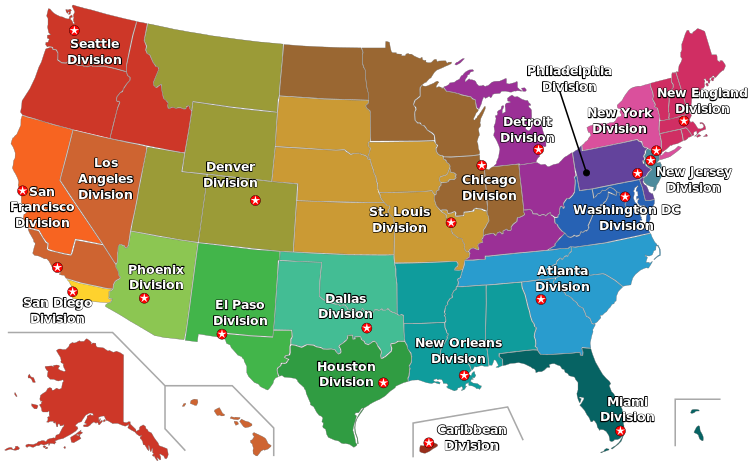Difference between revisions of "DEA"
(→Organization) |
(→Structure) |
||
| Line 22: | Line 22: | ||
<br> | <br> | ||
=== Structure === | === Structure === | ||
| − | Administrator | + | Administrator |
| − | + | Deputy Administrator | |
Human Resource Division | Human Resource Division | ||
Career Board | Career Board | ||
Revision as of 22:58, 24 July 2023
Contents
Introduction
The Drug Enforcement Administration (DEA) is a United States federal law enforcement agency under the U.S. Department of Justice tasked with combating illicit drug trafficking and distribution within the U.S. It is the lead agency for domestic enforcement of the Controlled Substances Act, sharing concurrent jurisdiction with the Federal Bureau of Investigation, the U.S. Immigration and Customs Enforcement, and U.S. Customs and Border Protection. However, the DEA has sole responsibility for coordinating and pursuing U.S. drug investigations both domestically and abroad.
It was established in 1973 as part of the U.S. government's War on Drugs. The DEA has an intelligence unit that is also a member of the U.S. Intelligence Community. While the unit is part of the DEA chain-of-command, it also reports to the Director of National Intelligence. The DEA has been criticized for scheduling drugs that have medical uses, and for focusing on operations that allow it to seize money rather than those involving drugs that cause more harm.
History and Mandate
The Drug Enforcement Administration was established on July 1, 1973, by Reorganization Plan No. 2 of 1973, signed by President Richard Nixon on July 28. It proposed the creation of a single federal agency to enforce the federal drug laws as well as consolidate and coordinate the government's drug control activities. Congress accepted the proposal, as they were concerned with the growing availability of drugs. As a result, the Bureau of Narcotics and Dangerous Drugs (BNDD), the Office of Drug Abuse Law Enforcement (ODALE); approximately 600 Special Agents of the Bureau of Customs, Customs Agency Service, and other federal offices merged to create the DEA.
From the early 1970s, DEA headquarters was located at 1405 I ("Eye") Street NW in downtown Washington, D.C. With the overall growth of the agency in the 1980s (owing to the increased emphasis on federal drug law enforcement efforts) and concurrent growth in the headquarters staff, DEA began to search for a new headquarters location; locations in Arkansas, Mississippi and various abandoned military bases around the United States were considered. However, then-Attorney General Edwin Meese determined that the headquarters had to be located close to the Attorney General's office. Thus, in 1989, the headquarters relocated to 600–700 Army-Navy Drive in the Pentagon City area of Arlington, Virginia, near the eponymous Metro station.
The Agency Under Threat
On April 19, 1995, Timothy McVeigh attacked the Alfred P. Murrah Federal Building in Oklahoma City because it housed regional offices for the Federal Bureau of Investigation (FBI), Bureau of Alcohol, Tobacco, Firearms and Explosives (ATF) and DEA, all of which had carried out raids that he viewed as unjustified intrusions on the rights of the people. This attack caused the deaths of two DEA employees, one task force member and two contractors in the Oklahoma City bombing. Subsequently, the DEA headquarters complex was classified as a Level IV installation under United States federal building security standards, meaning it was to be considered a high-risk law enforcement target for terrorists. Security measures include hydraulic steel roadplates to enforce standoff distance from the building, metal detectors and guard stations.
In February 2003, the DEA established a Digital Evidence Laboratory within its Office of Forensic Sciences.
Organization
The DEA is headed by an Administrator of Drug Enforcement appointed by the president of the United States and confirmed by the U.S. Senate. The Administrator reports to the Attorney General through the Deputy Attorney General. The administrator is assisted by a deputy administrator, the chief of operations, the chief inspector, and three assistant administrators (for the Operations Support, Intelligence, and Human Resources divisions). Other senior staff includes the chief financial officer and the chief counsel. The administrator and deputy administrator are the only presidentially appointed personnel in the DEA; all other DEA officials are career government employees. DEA's headquarters is located in Arlington, Virginia, across from the Pentagon. It maintains its own DEA Academy located on the Marine Corps Base Quantico at Quantico, Virginia, alongside the FBI Academy. It maintains 23 domestic field divisions with 222 field offices and 92 foreign offices in 70 countries. With a budget exceeding $3 billion, DEA employs 10,169 people, including 4,924 Special Agents and 800 Intelligence Analysts. Becoming a Special Agent or Intelligence Analyst with the DEA is a competitive process.
Structure
Administrator
Deputy Administrator
Human Resource Division
Career Board
Board of Professional Conduct
Office of Training
Operations Division
Aviation Division
Office of Operations Management
Special Operations Division
Office of Diversion Control
Office of Global Enforcement
Office of Financial Operations
Intelligence Division
Office of National Security Intelligence (ONSI)[16]
Office of Strategic Intelligence
Office of Special Intelligence
El Paso Intelligence Center
OCDETF Fusion Center
Financial Management Division
Office of Acquisition and Relocation Management
Office of Finance
Office of Resource Management
Operational Support Division
Office of Administration
Office of Information System
Office of Forensic Science
Office of Investigative Technology
Inspection Division
Office of Inspections
Office of Professional Responsibility
Office of Security Programs
Field Divisions and Offices
